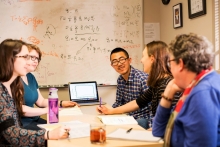It has become an almost essential element of academic life, from college lecture halls to elementary classrooms: the group assignment.
Dreaded by some, loved by others, group projects typically aim to build teamwork and accountability while students learn about a topic. But depending on the assignment and the structure of the groups, a project can turn out to be a source of great frustration — for instructor and students alike — or the highlight of the school year.
Now a University of Washington-led study of college students has found that the social dynamics of a group, such as whether one person dominates the conversation or whether students work with a friend, affect academic performance. Put simply, the more comfortable students are, the better they do, which yields benefits beyond the classroom.
“They learn more,” explained Elli Theobald, a postdoctoral researcher in the Department of Biology and the lead author on the study, published July 20 in PLOS ONE. “Employers are rating group work as the most important attribute in new recruits and new hires. If students are able to demonstrate that they have worked successfully in groups, it would seem that they should be more likely to land the job.”
Theobald is part of the UW’s Biology Education Research Group lab, formed by several faculty members in the Department of Biology about a decade ago to research how to most effectively teach biology to undergraduates.
A separate study by the BERG lab on group work, published in the July issue of Active Learning in Higher Education, finds that college students, when given a choice of whom to sit and work with in a large classroom setting, gravitate toward those who appear most like them — whether by gender, race and ethnicity, or academic skills.
Over the years, research spanning K-12 through post-secondary education has pointed to the value of group work in fostering collaborative skills and in cementing learning through interaction. In the sciences, labs are a common, though not the only, form of group work, Theobald said. As with many disciplines, STEM fields lend themselves to readings, worksheets and other activities that can be completed by multiple people working together.
For this study, researchers compared survey responses and test scores stemming from two different project styles — single-group and “jigsaw” — with three assignments each during two sections of an introductory biology class at the UW. Each of the 770 students enrolled in one of the two sections of the course experienced each project style at least once. In a single-group activity, student groups completed a worksheet together, relying on their notes and textbooks. In a jigsaw, student groups were assigned specific sections of the worksheet; students then were shuffled to new groups in which each person in the group had completed a different section of the worksheet and could teach their new groupmates what they had learned. Students took an eight-question test after each assignment.
The study found that students who reported a “dominator” in the group fared worse on the tests than those who didn’t express that concern. It also found that students who said they were comfortable in their group performed better than those who said they were less comfortable.
The jigsaw activity appeared to result in more collaboration: Students were 67 percent less likely to report a dominator in jigsaws than in single-group activities. “This suggests that jigsaw activities with intentional structure more effectively promote equity than group activities with less intentional structure,” researchers wrote.
Co-authors on the paper were Alison Crowe, principal lecturer in biology, and Benjamin Wiggins, faculty coordinator for biology instruction, both at the UW; Sarah Eddy of Florida International University; and Daniel Grunspan of Arizona State University.
Read the full article in UW News.

